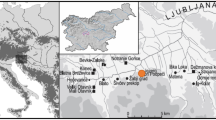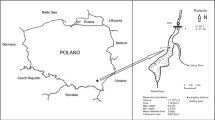Abstract
Wetlands of northern Belize provide a unique opportunity to study methane production and emissions from marshes dominated by identical species (Typha domingensis, Cladium jamaicense) and genus (Eleocharis spp.), but differing substantially in the amount of sulfates present in the sediments. Some marshes occur on limestone marls rich in gypsum (CaSO4) while others are underlain by alluvial sands poor in sulfates. Concentrations of methane and sulfates in the sediment interstitial water are one or more orders of magnitude different for these two geological substrata averaging 139.2 and 14.9 μM of CH4, and 0.08 and 11.53 mM of SO4 −2 2 on alluvial sands and limestone respectively. The amount of methane found in the internal atmosphere of plants from alluvial sands is significantly higher (6.3 μM) than in plants from limestone (0.19 μM). The average methane emissions measured in wetlands located on alluvial sands were 25.2 mg m−2 h−1 while emissions from marshes on limestone were only 2.4 mg m−2 h−1. These values extrapolated for the entire year and the respective wetland areas resulted in the estimate of total CH4 emissions from northern Belize of 0.066 Tg per year.
Similar content being viewed by others
References
Allen SE (1989) Chemical Analysis of Ecological Materials. Blackwell, Oxford
Bachoon D & Jones RD (1992) Potential rates of methanogenesis in sawgrass marshes with peat and marl soils in the Everglades. Soil Biol. Biochem. 24: 21–27
Barber T, Burke Jr. RA & Sackett WM (1988) Diffusive flux of methane from warm wetlands. Global Biochem. Cycles 2: 411–425
Bartlett KB & Harriss RC (1993) Review and assessment of methane emissions from wetlands. Chemosphere 26: 261–320
Bartlett KB, Bartlett DS, Harriss RC & Sebacher DI (1987) Methane emissions along a salt marsh salinity gradient. Biogeochemistry 4: 183–202
Bartlett KB, Crill PM, Sebacher SM, Harriss RC, Wilson JO & Melack JM (1988) Methane flux from the central Amazon floodplain. J. Geophys. Res. 93: 1571–1582
Blunier T, Chappellaz J, Schwander J, Stauffer B & Raynaud D (1995) Variations in atmospheric methane concentration during the Holocene epoch. Nature 374: 46–49
Bridgham SD, Johnston CA, Pastor J & Updegraff K (1995) Potential feedbacks of northern wetlands on climate change. BioScience 45: 262–274
Bubier JL & Moore TR (1994) An ecological perspective on methane emissions from northern wetlands. TREE 9: 460–464
Chanton JP & Whiting GJ (1995) Trace gas exchange in freshwater and coastal marine environments: ebullition and transport by plants. In: Matson PA & Harriss RC (Eds) Biogenic Trace Gases: Measuring Emissions from Soil and Water (pp 98–125). Blackwell, Oxford
Chanton JP, Whiting GJ, Happell JD & Ghislan G (1993) Contrasting rates and diurnal pattems of methane emission from emergent aquatic macrophytes. Aquatic Bot. 46: 111–128
DeLaune RD, Smith CJ & Patrick WH (1983) Methane release from Gulf coast wetlands. Tellus 35B: 8–15
Devol AH, Richey JE, Forsberg BR & Martinelli LA (1990) Seasonal dynamics in methane emissions from the Amazon River floodplain. J. Geophys. Res. 95: 16417–16426
Devol AH, Richey JE, Forsberg BR & Martinelli LA (1994) Environmental methane in the Amazon river floodplain. In: Mitsch WJ (Ed) Global Wetlands: Old World and New(pp 151–165). Elsevier, Amsterdam
Etheridge DM, Pearman GI & Fraser PJ (1992) Changes in tropospheric methane between 1841 and 1978 from a high accumulation-rate Antarctic ice core. Tellus 44B: 282–294
Gross MF, Hardisky MA, Wolf PL & Klemas V (1993) Relationships among Typha biomass, pore water methane, and reflectance in a Delaware (USA) brackish marsh. J. Cost. Res. 9: 339–355
High LR (1975) Geomorphology and sedimentology of holocene coastal deposits, Belize. In: Wantland KW & Pussey III WC (Eds) Belize Shelf-Carbonate Sediments, Clastic Sediments, and Ecology (pp 53–96). American Assoc. of Petroleum Geologists, Tulsa
Holmer M & Kristensen E (1994) Coexistence of sulfate reduction and methane production in an organic-rich sediment. Mar. Ecol. Progr. Ser. 107: 177–184
Janik M & Byron E (1987) Lake Tahoe Interagency Monitoring Program Quality Assurance Manual. DES, University of California, Davis
Keller M & Stallard RF (1994) Methane emission by bubbling from Gatun Lake, Panama. J. Geoph. Res. 99 D4: 8307–8319
King GM, Roslev P & Skovgaard H (1990) Distribution and rate of methane oxidation in sediments of the Florida Everglades. Appl. Environ. Microbiol. 56: 2902–2911
King RB, Ballie IC, Abel TMB, Dunsmore JR, Gray DA, Pratt JH, Versey HR, Wright ACS & Zisman SA (1992) Land Resources Assessment of Northern Belize. Natural Resources Institute Bulletin 43L 513 pp
Livingston GP & Hutchinson GL (1995) Enclosure-based measurement of trace gas exchange: applications and sources of error. In: Matson PA & Harriss RC (Eds) Biogenic Trace Gases: Measuring Emissions from Soil and Water (pp 14–51). Blackwell, Oxford
Lopez Ramos E (1979) Geologia de Mexico. Tomo 3, Mexico City
Martens CS & Klump JV (1984) Biogeochemical cycling in an organic-rich coastal marine basin, 4. An organic carbon budget for sediments dominated by sulfate reduction and methanogenesis. Geochim. Cosmochim. Acta 48: 1987–2004
Matson PA & Harriss RC (1995) Trace gas exchange in an ecosystem context: multiple approaches to measurement and analysis. In: Matson PA & Harriss RC (Eds) Biogenic Trace Gases: Measuring Emissions from Soil and Water (pp 1–13). Blackwell, Oxford
McAullife C (1971) GC determination of solutes by multiple phase equilibration. Chem. Technol. 1: 46–51
McKee KL, Mendelssohn IA & Hester M (1988) Reexamination of pore-water sulfide concentrations and redox potentials near aerial roots of Rhizophora mangle and Avicennia germinans. Amer. J. Bot. 75: 1352–1359
Missimer TM (1984) The geology of South Florida. In: Gleason P (Ed) Environments of South Florida. Present and Past. Miami Geol. Soc., Coral Gables
Morrissey LA & Livingston GP (1992) Methane emissions from Alaska arctic tundra: an assessment of local spatial variability. J. Geophys. Res. 97: 16661–16670
Rejmankova E, Pope KO, Post B & Maltby E (In press) Herbaceous wetlands of the Yucatan Peninsula: Communities at extreme ends of environmental gradients. Int. Rev. Ges. Hydrobiol
Richey JE, Devol AH, Wofsy SC, Victoria R & Riberio MNG (1988) Biogenic gases and the oxidation reduction of carbon in Amazon River floodplain waters. Limnol. Oceanogr. 33: 551–561
Schipper LA & Reddy KR (1994) Methane production and emissions from four reclaimed and pristine wetlands in Southeastern United States. Soil Sci. Soc. Am. J. 58: 1270–1275
Schutz H, Seiler W & Conrad R (1989) Processes involved in formation and emission of methane in rice paddies. Biogeochemistry 7: 33–53
Sebacher DI, Harriss RC & Bartlett KB (1985) Methane emissions to the atmosphere through aquatic plants. J. Environ. Qual. 14: 40–46
Sorrell BK & Boon PI (1994) Convective gas flow in Eleocharis sphacelata R. Br.: methane transport and release from wetlands. Aquatic Bot. 47: 197–212
Stauffer B, Fisher G, Neftel A & Oeschger H (1985) Increase of atmospheric methane recorded in an Antarctic ice core. Science 229: 1386–1388
Valentine DW, Holland EA & Schimel DS (1994) Ecosystem and physiological controls over methane production in northern wetlands. J. Geophys. Res. 99: 1563–1571
Ward WC (1985) Quaternary geology of the northeastern Yucatan Peninsula. In: Ward WC, Weidie AE & Back W (Eds) Geology and Hydrology of the Yucatan and Quaternary Geology of Northeastern Yucatan Peninsula (pp 23–95). New Orleans Geological Society, New Orleans
Weidie AE (1985) Geology of the Yucatan platform. In: Ward WC, Weidie AE & Back W (Eds) Geology and Hydrology of the Yucatan and Quaternary Geology of Northeastern Yucatan Peninsula (pp 1–19). New Orleans Geological Society, New Orleans
Wolin MJ & Miller TL (1987) Bioconversion of organic carbon to CH4 and CO2, Geomicrobiol. J. 5: 239–259
Wright ACS, Romney DH, Arbucle RH & Vial VE (1959) Land in British Honduras. - Her Majesty's Stationery Office. London
Author information
Authors and Affiliations
Rights and permissions
About this article
Cite this article
Rejmankova, E., Post, R.A. Methane in sulfate-rich and sulfate-poor wetland sediments. Biogeochemistry 34, 57–70 (1996). https://doi.org/10.1007/BF02180973
Received:
Accepted:
Issue Date:
DOI: https://doi.org/10.1007/BF02180973




